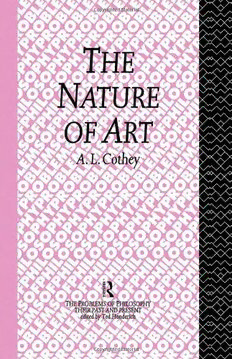
The Nature of Art PDF
Preview The Nature of Art
The Nature of Art The Problems of Philosophy: Their Past and Present General Editor: Ted Honderich Grate Professor of the Philosophy of Mind ana’ Logic llniversity College, London Each book in this series is written to bring into view and to deal with a great or significant problem of philosophy. The books are intended to be accessible to undergraduates in philosophy, and to other readers, and to advance the subject, making a contribution to it. The first part of each book presents the history of the problem in question, in some cases its recent past. The second part, of a contemporary and analytic kind, defends and elaborates the author’s preferred solution. Private Ownership James 0. Grunebaum Religious Belief and the Will Louis P. Pojman Rationality Harold I. Brown The Rational Foundations of Ethics TLS. Sprigge Moral Knowledge Alan H. Goldman Mind-body Identity Theories Cynthia Macdonald FVacti cal Reasoning Robert Audi Personal Identity Harold W. Noonan If P then Q: the Foundations of Logic and Argument David H. Sanford The Infinite A.W. Moore Thought and Language Julius Moravcsik Human Consciousness Alastair Hannay Explaining Explanation David Hillel-Ruben The Weakness of the Will Justin Gosling The Nature of Art A. L. Cothey London and New York First published 1990 by Routledge 11 New Fetter Lane, London EC4P 4EE Simultaneously published in the USA and Canada by Routledge a division of Routledge, Chapman and Hall, Inc. 29 West 35th Street, New York, NY 10001 8 1990 A. L. Cothey Typeset by LaserScript Liited, Mitcham, Surrey Printed in Great Britain by Biddies Ltd. Guildford All rights reserved. No part of this book may be reprinted or reproduced or utilized in any form or by any electronic, mechanical, or other means, now known or hereafter invented, including photocopying and recording, or in any information storage or retrieval system, without permission in writing from the publishers. British Library Cutaloguing in Publication Dnta Cothey. A. L. (Antony L.) The nature of art. 1. Arts. Aesthetics. Theories I. Title 700.1 Library of Congress Cataloging in Publication Data applied for Cothey. A.L. (Antony L.). The nature of art / A.L. Cothey. p. cm.- (The Problems of philosophy) Includes bibliographical references. ISBN O-415-03357-8 1. Aesthetics. 2. Art-Philosophy. I. Title. II. Series: Problems of philosophy (Routhledge (Firm)) BH39C67 1990 701’.17-dc20 90-32935 CIP ISBNO 415 03357 8 To my parents Contents Preface xi Introduction 1 1. Art is anomalous 1 2. Forms of aesthetic scepticism: philistines and iconoclasts 3. Historical note 4. The central issues 5. Aestheticism I Hedonism and the Theory of Taste 8 1. General objections 8 2. Beauty as a secondary quality: Hutcheson, Reid, Burke 10 3. Beauty as a primary quality: Santayana. Bell 14 4. Hume’s theory 17 II Theories that Assign a Direct Practical F’urpose to Art 21 1. Nutritional and medicinal analogies 21 2. General difficulties 22 3. Art as substitute satisfaction: Freud 23 4. Tolstoy’s theory 26 5. Art as a pseudo-capacity: Plato 30 6. Beauty and inspiration: Plato 32 1. Metaphysical aestheticism: Plotinus 36 III Perfection and the Play of Cognition 40 1. Aristotle’s theory of pleasure 40 2. Beauty and perfection: a dilemma 42 vii Contents 3. Rationalist aesthetics: Leibniz, Baumgarten 44 4. Kant’s theory (I): the existence of a non-cognitive aim of cognition 48 5. Kant’s theory (2): the sublime and the moral signijicance of beauty 52 IV Art as the Experience of Metaphysical Truth 58 1. The reception of Kant’s theory: Schiller, Schelling 58 2. Art and nature: Schelling 61 3. Art as the ‘sensuous presentation of the Absolute’ : Hegel 64 4. Hegel’s iconoclasm 67 5. Art as respite: Schopenhauer 69 6. Schopenhauer on music 72 I. Conclusion: the needfor a theory offorms of knowledge 75 V Art as Language 77 1. Knowledge by acquaintance 77 2. The phenomenological approach: Dufrenne 79 3. Croce’s theory of intuition and expression 83 4. Presentational symbols: Langer 87 5. Art and the general theory of symbols: Goodman 91 VI Art and Metaphor 96 1. The relevance of metaphor 96 2. Theories of metaphor 98 3. Literalist and tropist prejudices loo 4. Dead and faint metaphor 102 5. Viewpoints and exponability 106 6. Art as metaphor 108 7. Unanswered questions 113 VII Virtues and Indirect Pleasures 116 1. A problem about pleasure and ‘completeness’ 116 2. Cognitive virtues 118 3. A pragmatic theory of beauty 120 4. Art as recreation 124 5. The ‘institutional’ theory of art 127 6. Cognitive pleasure: Aristotle on happiness 131 . . . Vlll Contents VIII The Aim Behind Perception 134 1. Cognition and the essentially metaphorical 134 2. The intellect and the senses: Aristotle 137 3. Further problems in understanding particulars 140 4. The imagination as a pseudo-capacity 143 5. Perception and kinaesthetic experience 146 6. Productive skills and conceptual empathy 149 IX Aesthetic Satisfaction 152 1. Peculiarities of aesthetic enjoyment 152 2. Perceptual knowledge 156 3. Aesthetic understanding (I): empathic enjoyment 161 4. Aesthetic understanding (2): beauty and necessity 164 5. Beauty and experiential knowledge 167 X Art and Artistic Abilities 171 1. Questions about art 171 2. Two theories of artistic abilities 173 3. Creative imagination 175 4. Inspiration and works of art 177 5. Inspiration and artistic success 179 6. Understanding art 182 7. The value of art: aesthetic experience as a source of meaning 186 Bibliography 190 Index 195 ix
